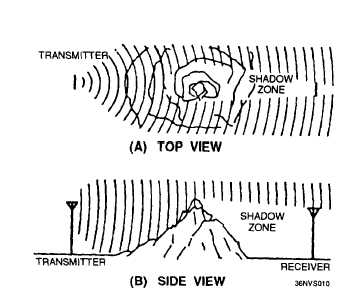waves reflected from the earth’s surface. Waves A
and B bounce off the earth’s surface like light off of
a mirror.
Notice that the positive and negative
alternations of radio waves A and B are in phase before
they strike the earth’s surface.
However, after
reflection the radio waves are approximately 180
degrees out of phase. A phase shift has occurred.
The amount of phase shift that occurs is not
constant. It varies, depending on the wave polarization
and the angle at which the wave strikes the surface.
Because reflection is not constant, fading occurs.
Normally, radio waves reflected in phase produce
stronger signals, while those reflected out of phase
produce a weak or fading signal.
Ionospheric reflection occurs when certain radio
waves strike a thin, highly ionized layer in the
ionosphere. Although the radio waves are actually
refracted, some may be bent back so rapidly that they
appear to be reflected. For ionospheric reflection to
occur, the highly ionized layer can be approximately
no thicker than one wavelength of the wave. Since
the ionized layers are often several miles thick,
ionospheric reflection mostly occurs at long wave-
lengths (low frequencies).
DIFFRACTION
Diffraction is the ability of radio waves to turn
sharp corners and bend around obstacles. Shown in
figure 1-10, diffraction results in a change of direction
of part of the radio-wave energy around the edges of
an obstacle.
Radio waves with long wavelengths
compared to the diameter of an obstruction are easily
propagated around the obstruction. However, as the
wavelength decreases, the obstruction causes more
and more attenuation, until at very-high frequencies
a definite shadow zone develops. The shadow zone
is basically a blank area on the opposite side of an
obstruction in line-of-sight from the transmitter to the
receiver.
Diffraction can extend the radio range beyond the
horizon. By using high power and low-frequencies,
radio waves can be made to encircle the earth by
diffraction.
Figure 1-10.—Diffraction around an object.
ATMOSPHERIC EFFECTS
ON PROPAGATION
As we stated earlier, changes in the ionosphere
can produce dramatic changes in the ability to
communicate.
In some cases, communications
distances are greatly extended. In other cases,
communications distances are greatly reduced or
eliminated. The paragraphs below explain the major
problem of reduced communications because of the
phenomena of fading and selective fading.
Fading
The most troublesome and frustrating problem in
receiving radio signals is variations in signal strength,
most commonly known as FADING.
Several
conditions can produce fading. When a radio wave
is refracted by the ionosphere or reflected from the
earth’s surface, random changes in the polarization
of the wave may occur. Vertically and horizontally
mounted receiving antennas are designed to receive
vertically and horizontally polarized waves, respec-
tively. Therefore, changes in polarization cause
changes in the received signal level because of the
inability of the antenna to receive polarization changes.
Fading also results from absorption of the rf energy
in the ionosphere. Most ionospheric absorption occurs
in the lower regions of the ionosphere where ionization
1-8


